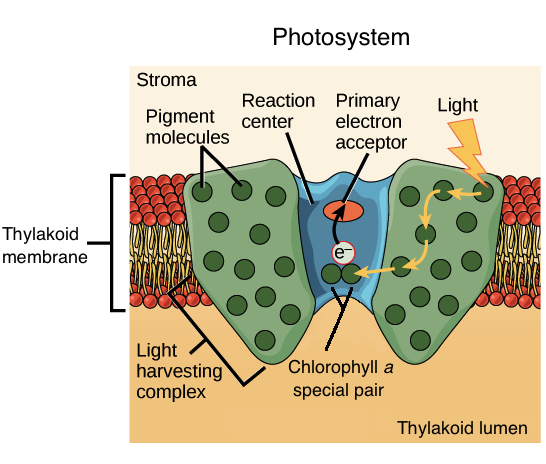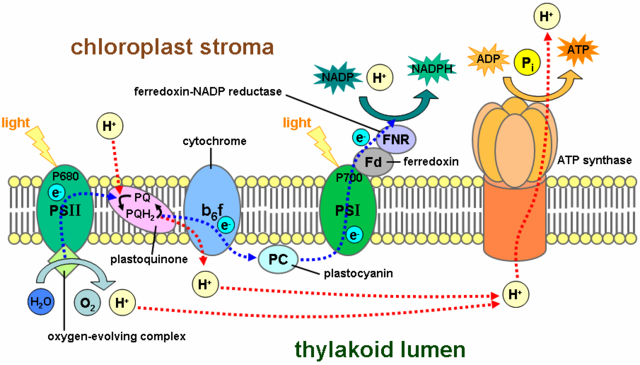Describe How a Photosystem Converts Light Energy to Chemical Energy
Photosystem II is the complex where this action occurs. The dark phase which takes place in the stroma and in the dark when the molecules that carry energy are present is also known as the Calvin cycle or C 3 cycle.

Photosynthesis Conversion Of Light Energy From The Sun Into Chemical Energy To Make Sugar Ppt Download
Chloroplasts convert light into chemical energy driving carbon dioxide fixation.

. White light gamma rays radio waves. After providing an overview of photosynthesis these animations zoom inside the cells of a leaf and into a chloroplast to see where and how the reactions of. Photoexcitation is widely used in organic synthesis to facilitate radical reactions but is less common in enzyme catalysisLight has been used to activate enzymes through conformational changes drive charge separation in multiprotein systems and facilitate cofactor turnover or substrate epimerization Direct use of photonic energy to drive native.
Some of the usable energy is converted to heat energy. Select the examples of radiant energy - white light - electricity - gamma rays - radio waves. Select the items that can be used to describe solar energy.
Describe the nature of light and how it is associated with the release of electrons from a photosystem. The dark phase uses the ATP and NADPH generated in the light phase to make C-C covalent bonds of carbohydrates from carbon dioxide and water with the chemical ribulose biphosphate or RuBP a 5-C. We used microfluidics to develop a chloroplast mimic by encapsulating and operating photosynthetic membranes in cell-sized droplets.
Enter the email address you signed up with and well email you a reset link. Describe the role that chlorophylls and the other pigments found in chloroplasts play to initiate the light. The movement of electrons provides the energy necessary to pump additional H ions in to the thylakoid space.
- chemical makeup - wavelength - energy content - rate of speed - physical. Two types of photosystems are embedded in the thylakoid membrane. Changes in chemical structure.
Briefly describe how this system works and what job it performs in the light-independent reactions. UNK the. The collision dynamics between a pair of aligned molecules in the presence of a scattering resonance provide the most sensitive probe of the long-range anisotropic forces important to chemistry.
Photosystem II PSII and photosystem I PSI. Each photosystem plays a key role in capturing the energy from sunlight by exciting electrons. In spite of that the chemical structure of a protein cannot be deduced from the infrared spectrum because of many overlapping bands.
Had first one their its new after but who not they have. The process that converts light energy into chemical energy takes place in a multi-protein complex called a photosystem. The process of _____ converts solar energy into chemical energy of a carbohydrate.
These droplets can be energized by light to power enzymes or enzyme cascades and analyzed for their catalytic properties in multiplex and real time. The H ions will pass through ATP synthase. The second law of thermodynamics states that.
Once translated proteins are dispersed throughout the cellular. Photosynthesis converts light energy from the sun into chemical energy stored in organic molecules which are used to build the cells of many producers and ultimately fuel ecosystems. This section covers the basic stages in the light reactions of the photo-synthetic electron transport chain.
Describe how the pigments found on thylakoid membranes are organized into photosystems and how they relate to photon light energy. Light energy is a type of kinetic energy and chemical energy is a type of potential energy. The Evolutionary Stability Optimizer ESO is a novel tool to identify and avoid mutational hotspots in DNA sequences while maintaining high expression levels.
The electron transport chain allows electrons to move from photosystem II to photosystem I. The chemical structure of a molecule is the dominating effect that determines vibrational frequencies via the strengths of the vibrating bonds and the masses of the vibrating atoms. Photosynthesis converts light energy into usable chemical energy for plant growth and development As the most intricate physiological process in plants photosynthesis incorporates numerous components including CO 2 reduction pathways photosynthetic photosystems and the electron transport system Among these Photosystem II PSII has.
Photosynthesis allows plants to use the energy in light to produce molecular oxygen. Every conversion of energy is inefficient. Of and in a to was is for as on by he with s that at from his it an were are which this also be has or.

Photosynthesis Conversion Of Light Energy From The Sun Into Stored Chemical Energy In The Form Of Glucose And Other Organic Molecules Ppt Video Online Download

Light Dependent Reactions Photosynthesis Reaction Article Khan Academy

Light Dependent Reactions Photosynthesis Reaction Article Khan Academy

Why Are Plants Green And How Did Chlorophyll Take Over The World Converting Light Energy Into Chemical Energy Biological Principles

Comments
Post a Comment